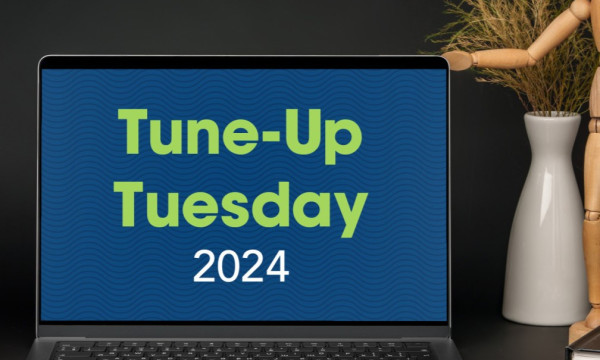Getting SMART: A plan for a better life
Recently, we got together with Sam Dolezal, UBT’s Wellbeing Officer. We know that January is typically a reset month for folks and that much goal setting takes place. We wondered if Sam, in her infinite wellness-based wisdom, had any ideas on making new year’s resolutions — or any long-term aspirations — stick, and sure enough, she did. Sam took us through setting and achieving goals through SMART Planning today in order to be your best tomorrow. Here, we’ll talk through the tips she highlights in the video.
SMART — and so simple
Using the SMART goal structure can help you set goals that are detailed and realistic, setting you up for progress, and ultimately, success. You may be familiar with the SMART acronym: specific, measurable, attainable, realistic, and time-bound.
Using SMART planning, goals can be set in any number of areas: financial, physical, emotional, mental health — really anything that you’d like to do to improve yourself. Sam gave two specific examples by applying SMART planning principles to two common (and intentionally broad) objectives: work out more and save for a car. How does SMART planning to each of those goal threads, you ask? Let’s look at that goal to improve physical wellness by making trips to the gym.
- Specific — This is where you decide which gym and how often, outlining detail.
- Measurable — In order to measure your success, you’ll need to come up with indicators that help you decide if you’re meeting your goal. For example, you’ll decide the number of times per week you’ll visit the gym and how long your workouts will be.
- Attainable — If going to the gym is your goal, but you haven't gone in over a year, maybe going every day is a pretty heavy lift — figuratively and literally. But if you start out by going every Monday for a few weeks and increasing from there, that’s much more attainable.
- Realistic — While realistic and attainable seem pretty closely related (and they are), Sam provides examples of choosing a realistic workout plan for the gym, or examining if a gym workout is even the type of exercise that is going to work for you.
- Time-bound — The beauty of SMART planning is that it looks different for everyone, this step especially. The time phase of your plan will keep changing as you progress on your wellness journey, as you won’t want to make it too aggressive at the outset. As you grow, you’ll keep moving the goal post with increased frequency and duration.
Sam also walked us through financial wellness using the SMART Planning module. In this instance, we’re saving for a car.
- Specific — This is where you would outline the type of car you want, and how much it will cost. You’ll factor in your down payment and other details, setting yourself up for as much financial success as possible.
- Measurable — Working within any pre-determined parameters (maybe you need a car ASAP, or you have the luxury of planning out a ways), you’ll begin to decide how much you can set aside, and how often.
- Attainable — Reviewing your “M” step, you’ll ask yourself if your step to measure your success is truly measurable and achievable. In the case of the new car, looking at the amount you are setting aside in light of your overall budget would be key.
- Realistic — Building on the earlier steps, you’ll want to make certain your goals are financially feasible, and even the best steps for you on this journey to a new car. Do you want it, do you need it, and can you do it, are all great questions to ask yourself based on your outline.
- Time-bound — This step is connected to the first step (specific) and in even more detail. When we’re talking about the new car, we’ll review parameters, solidify the timetable you’ve given yourself in which to save as well as the actual amount you’re putting aside, and verify the amount you already have to put toward your goal.
While having a workable, reasonable, detailed plan in place helps you reach your goals, you’ll need some other tools in your toolbox for when the going gets tough. Sam goes on to explain her favorite wellness adages and how they apply when you’re planning your way to a better you.
Consistency is king
Being consistent versus perfect is the best way to create a long-term change and vision. Sam’s examples of planning to create consistency include scheduling the event or action on your calendar, doing as much advance prep as possible, talking about it to your accountability partner, and signing up for a workout class (or, in the case of financial wellness, an auto withdrawal to a separate account) ahead of time. As motivation wanes, a fresh look at your workout, reviewing your amassed funds or finding a new infusion of energy through a routine change or adding a reimbursement to your savings may be just the inspiration you need to keep going. Perfection has no place here, only progress.
Slow and steady wins the race
Making small changes and building versus trying to do all of the changes at the same time is the way to progress; slowly creating healthy habits. Thus, says Sam, “slow and steady wins the race.” And since we know that what we're aiming for is more of a lifestyle than a true goal, whether it's exercising more, eating better, being financially savvy, we're looking at these things from a long-term perspective. Perhaps we want to achieve portions of them in the short term, then keep going for perpetual and increased success as we keep moving our marker. So, from a physical wellness perspective, rest days are important. Working out every day may not be realistic or attainable for you. The same with the financial wellness, or new car, example: marathon saving is not possible, while developing healthy saving habits set you up for all kinds of “next steps.” When you begin to measure your success by small, attainable wins, you’ll be surprised how your confidence is bolstered.
Find your people
Sam encourages us to turn to those who can help support us on our journey: a spouse, kids, personal trainer, financial planner, family, friends…locating our people and leaning on them can be an invaluable part of success, as we all do better with a cheerleader (or several.) Share your plan, she says, and help them help you achieve those goals that you have set forth.
We appreciate Sam’s words of wisdom, and invite you to check out Sam’s video, then, in her words, get out there, get SMART, and good luck!
Learning Center articles, guides, blogs, podcasts, and videos are for informational purposes only and are not an advertisement for a product or service. The accuracy and completeness is not guaranteed and does not constitute legal or tax advice. Please consult with your own tax, legal, and financial advisors.




